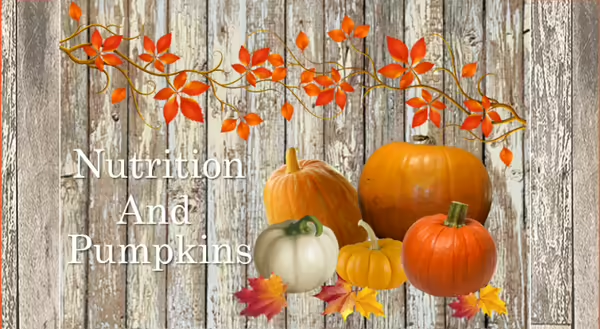
Whether used in a savory soup, added to quick breads, or your beloved family pie, pumpkins are a fall favorite for many, and very versatile.
This fruit is packed full of key nutrients our bodies need. Yes, I said fruit. Fun fact, although pumpkins have a nutritional profile like that of a vegetable, they are botanically a fruit since they contain seeds.
Pumpkin is an excellent nutrient-dense addition to your fall menu. They are a great source of Vitamins A and C, potassium, fiber, and are low in calories. Pumpkin is also rich in carotenoids. Carotenoids are the naturally occurring pigment found in fruits and vegetables, such as in pumpkins, carrots, dark green leafy greens, and cantaloupe, giving them their bright orange, green and yellow colors. There are more than 700 types of carotenoids, which have antioxidant properties.
Consuming a diet rich in antioxidants helps to protect our cells from the damage caused by free radicals. Free radicals are naturally occurring byproducts of chemical processes, such as metabolism, which occur in our bodies. Therefore, there is no escaping them. However, by consuming a diet rich in antioxidants, including beta-carotene, lycopene, lutein, selenium, and vitamins A, C, and E, we can counteract some of their harmful damage. You can find antioxidants in both fruits and vegetables, so aim to make half your plate fruit and vegetables.
Selecting your pumpkin
Before selecting your pumpkin, you have to decide what the pumpkin’s intended use will be. This is because, like many things in life, not all pumpkins are created equal. Thus, if you are planning on cooking or baking with your pumpkin, you should consider these factors.
Processing/Baking Pumpkins
Processing pumpkins, sometimes called “pie” or “sweet” pumpkins, are more desirable for baking or cooking. These pumpkins have high sugar content, are more flavorful, less watery, and have smooth-textured flesh. Pie pumpkins are generally smaller and have a less grainy texture compared to jack-o-lantern pumpkins.
When selecting baking pumpkins, pick smaller pumpkins, ideally between 4-8 pounds. If you do not have a scale handy, simply choose a pumpkin that seems heavy for its size; this will indicate a great pumpkin!
Select a firm, unblemished pumpkin, free of soft spots, nicks, cuts, or cracks. You will also want to make sure your pumpkin has a stem, especially if you are not planning to bake it in the immediate future.
Ornamental/Decorative Pumpkins
More likely than not, if you are at a pumpkin farm and picking your own pumpkin, you are buying an ornamental pumpkin. These pumpkins are great for decorating and carving. They generally have bright orange smooth skin, can be very large, and have a stem.
Although you may be tempted, it is important to understand the stem is not intended to be a handle. Once the stem breaks off, that section of the pumpkin becomes exposed, increasing the chance of the pumpkin spoiling prematurely.
Other common names for ornamental pumpkins are carving or jack-o-lantern pumpkins. These pumpkins can be used for baking; however, they generally have a bland taste, tend to be watery, and often have a very stringy texture.
Storing pumpkins
Pumpkins have a long shelf life. If stored correctly, you can keep pumpkins for three to six months. Store pumpkins in a cool, dark location, between 45-50°F. Make sure they are stored away from any ripening fruit or vegetables such as apples, potatoes, or tomatoes. During the ripening process, these foods release ethylene gas, which may shorten the life of your pumpkin.
During storage, the color of your pumpkin may change and become dull due to aging. Do not be alarmed by this; it does not mean your pumpkin quality has decreased. In fact, in some varieties of pumpkins, the sugar content may increase.
Fun Fact:
You can also use winter squash as a substitute for cooking pumpkins. Try it and see if anyone in your family can tell the difference!
Are you looking for an easy no-bake pumpkin pie? No-bake pumpkin pie recipe.!
Source: Diane Reinhold, MPH, MS, RDN is a University of Illinois Extension, Educator, Nutrition and Wellness, serving Jo Daviess, Stephenson & Winnebago Counties